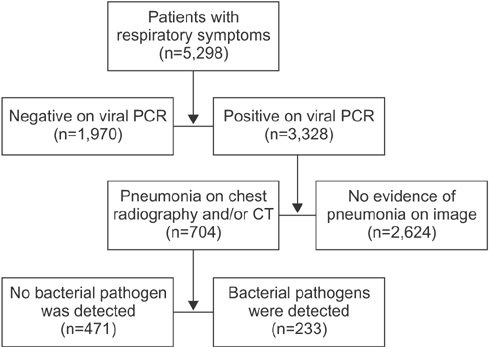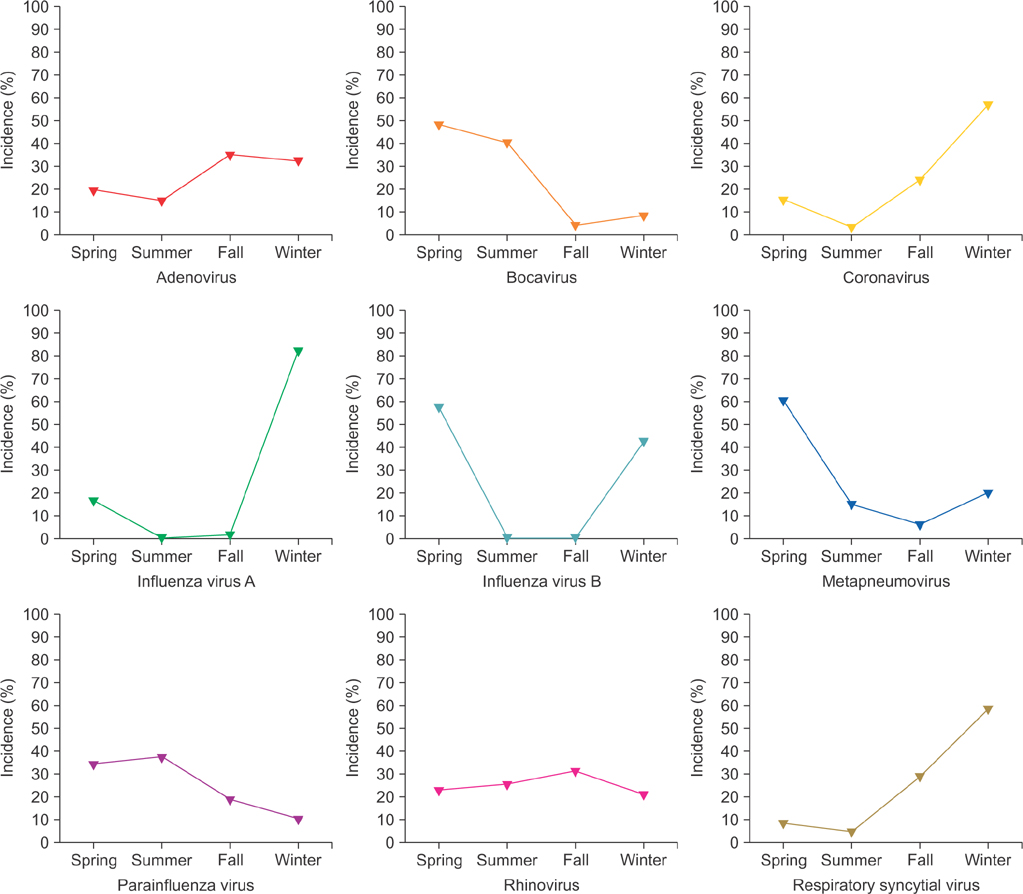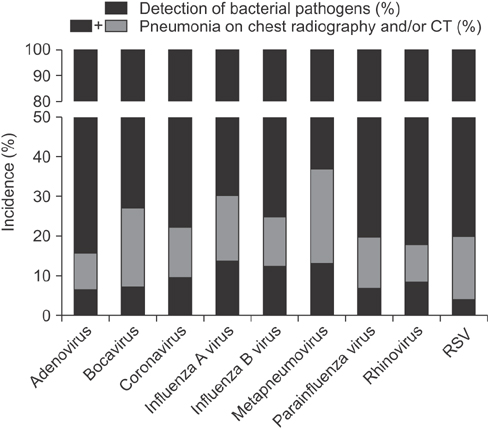Tuberc Respir Dis.
2017 Oct;80(4):358-367. 10.4046/trd.2017.0044.
Elucidation of Bacterial Pneumonia-Causing Pathogens in Patients with Respiratory Viral Infection
- Affiliations
-
- 1Department of Internal Medicine, Ulsan University Hospital, University of Ulsan College of Medicine, Ulsan, Korea. ddol1996@hanmail.net, drahnjj@gmail.com
- 2Department of Laboratory Medicine, Ulsan University Hospital, University of Ulsan College of Medicine, Ulsan, Korea.
- KMID: 2420578
- DOI: http://doi.org/10.4046/trd.2017.0044
Abstract
- BACKGROUND
Bacterial pneumonia occurring after respiratory viral infection is common. However, the predominant bacterial species causing pneumonia secondary to respiratory viral infections other than influenza remain unknown. The purpose of this study was to know whether the pathogens causing post-viral bacterial pneumonia vary according to the type of respiratory virus.
METHODS
Study subjects were 5,298 patients, who underwent multiplex real-time polymerase chain reaction for simultaneous detection of respiratory viruses, among who visited the emergency department or outpatient clinic with respiratory symptoms at Ulsan University Hospital between April 2013 and March 2016. The patients' medical records were retrospectively reviewed.
RESULTS
A total of 251 clinically significant bacteria were identified in 233 patients with post-viral bacterial pneumonia. Mycoplasma pneumoniae was the most frequent bacterium in patients aged <16 years, regardless of the preceding virus type (p=0.630). In patients aged ≥16 years, the isolated bacteria varied according to the preceding virus type. The major results were as follows (p<0.001): pneumonia in patients with influenza virus (type A/B), rhinovirus, and human metapneumovirus infections was caused by similar bacteria, and the findings indicated that Staphylococcus aureus pneumonia was very common in these patients. In contrast, coronavirus, parainfluenza virus, and respiratory syncytial virus infections were associated with pneumonia caused by gram-negative bacteria.
CONCLUSION
The pathogens causing post-viral bacterial pneumonia vary according to the type of preceding respiratory virus. This information could help in selecting empirical antibiotics in patients with post-viral pneumonia.
MeSH Terms
-
Ambulatory Care Facilities
Anti-Bacterial Agents
Bacteria
Coronavirus
Emergency Service, Hospital
Gram-Negative Bacteria
Humans
Influenza, Human
Medical Records
Metapneumovirus
Mycoplasma pneumoniae
Orthomyxoviridae
Paramyxoviridae Infections
Pneumonia
Pneumonia, Bacterial
Pneumonia, Mycoplasma
Pneumonia, Staphylococcal
Real-Time Polymerase Chain Reaction
Respiratory Syncytial Virus Infections
Retrospective Studies
Rhinovirus
Ulsan
Anti-Bacterial Agents
Figure
Reference
-
1. Jain S, Self WH, Wunderink RG, Fakhran S, Balk R, Bramley AM, et al. Community-acquired pneumonia requiring hospitalization among U.S. adults. N Engl J Med. 2015; 373:415–427.2. Jain S, Williams DJ, Arnold SR, Ampofo K, Bramley AM, Reed C, et al. Community-acquired pneumonia requiring hospitalization among U.S. children. N Engl J Med. 2015; 372:835–845.3. Mandell LA, Wunderink RG, Anzueto A, Bartlett JG, Campbell GD, Dean NC, et al. Infectious Diseases Society of America/American Thoracic Society consensus guidelines on the management of community-acquired pneumonia in adults. Clin Infect Dis. 2007; 44:Suppl 2. S27–S72.4. American Thoracic Society. Infectious Diseases Society of America. Guidelines for the management of adults with hospital-acquired, ventilator-associated, and healthcare-associated pneumonia. Am J Respir Crit Care Med. 2005; 171:388–416.5. Magiorakos AP, Srinivasan A, Carey RB, Carmeli Y, Falagas ME, Giske CG, et al. Multidrug-resistant, extensively drug-resistant and pandrug-resistant bacteria: an international expert proposal for interim standard definitions for acquired resistance. Clin Microbiol Infect. 2012; 18:268–281.6. Klein EY, Monteforte B, Gupta A, Jiang W, May L, Hsieh YH, et al. The frequency of influenza and bacterial coinfection: a systematic review and meta-analysis. Influenza Other Respir Viruses. 2016; 10:394–403.7. Chertow DS, Memoli MJ. Bacterial coinfection in influenza: a grand rounds review. JAMA. 2013; 309:275–282.8. Rice TW, Rubinson L, Uyeki TM, Vaughn FL, John BB, Miller RR 3rd, et al. Critical illness from 2009 pandemic influenza A virus and bacterial coinfection in the United States. Crit Care Med. 2012; 40:1487–1498.9. Kumar A, Roberts D, Wood KE, Light B, Parrillo JE, Sharma S, et al. Duration of hypotension before initiation of effective antimicrobial therapy is the critical determinant of survival in human septic shock. Crit Care Med. 2006; 34:1589–1596.10. Rello J, Gallego M, Mariscal D, Sonora R, Valles J. The value of routine microbial investigation in ventilator-associated pneumonia. Am J Respir Crit Care Med. 1997; 156:196–200.11. Watt JP, Moisi JC, Donaldson RL, Reid R, Ferro S, Whitney CG, et al. Measuring the incidence of adult community-acquired pneumonia in a Native American community. Epidemiol Infect. 2010; 138:1146–1154.12. Cherian T, Mulholland EK, Carlin JB, Ostensen H, Amin R, de Campo M, et al. Standardized interpretation of paediatric chest radiographs for the diagnosis of pneumonia in epidemiological studies. Bull World Health Organ. 2005; 83:353–359.13. Lehtinen P, Jartti T, Virkki R, Vuorinen T, Leinonen M, Peltola V, et al. Bacterial coinfections in children with viral wheezing. Eur J Clin Microbiol Infect Dis. 2006; 25:463–469.14. Khadadah M, Essa S, Higazi Z, Behbehani N, Al-Nakib W. Respiratory syncytial virus and human rhinoviruses are the major causes of severe lower respiratory tract infections in Kuwait. J Med Virol. 2010; 82:1462–1467.15. Pitkaranta A, Roivainen M, Blomgren K, Peltola J, Kaijalainen T, Raty R, et al. Presence of viral and bacterial pathogens in the nasopharynx of otitis-prone children: a prospective study. Int J Pediatr Otorhinolaryngol. 2006; 70:647–654.16. Lin PY, Lin TY, Huang YC, Tsao KC, Huang YL. Human metapneumovirus and community-acquired pneumonia in children. Chang Gung Med J. 2005; 28:683–688.17. Lieberman D, Shimoni A, Shemer-Avni Y, Keren-Naos A, Shtainberg R, Lieberman D. Respiratory viruses in adults with community-acquired pneumonia. Chest. 2010; 138:811–816.18. Self WH, Williams DJ, Zhu Y, Ampofo K, Pavia AT, Chappell JD, et al. Respiratory viral detection in children and adults: comparing asymptomatic controls and patients with community-acquired pneumonia. J Infect Dis. 2016; 213:584–591.19. Hasvold J, Sjoding M, Pohl K, Cooke C, Hyzy RC. The role of human metapneumovirus in the critically ill adult patient. J Crit Care. 2016; 31:233–237.
- Full Text Links
- Actions
-
Cited
- CITED
-
- Close
- Share
- Similar articles
-
- Corrigendum: Elucidation of Bacterial Pneumonia-Causing Pathogens in Patients with Respiratory Viral Infection
- Antibiotics for bacterial pneumonia in children
- Bacterial Upper Respiratory Infections
- The frequency and seasonal distribution of viral infection in patients with community-acquired pneumonia and its impact on the prognosis
- High Incidence of Staphylococcus aureus and Norovirus Gastroenteritis in Infancy: A Single-Center, 1-Year Experience






